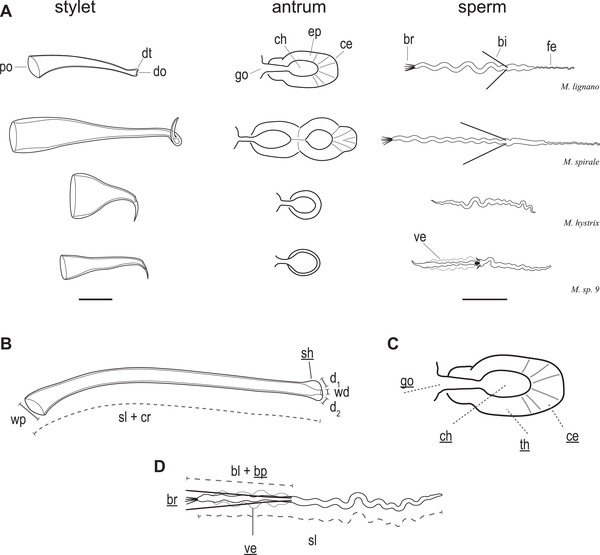Figure 1.

(A) Representative drawings of the morphology of the stylet (male intromittent organ), the antrum (female reproductive organ), and the sperm of four Macrostomum species. The well‐studied model M. lignano represents the typical morphology for reciprocally mating species, showing a stylet with wide proximal opening (po), blunt distal thickenings (dt) on the distal opening (do) and a complex sperm with an anterior feeler (fe), two stiff lateral bristles (bi), and a terminal brush (br). Moreover, the antrum has a single genital opening (go), and a single chamber (ch) with a thickened antrum epithelium (ep) and a cellular valve (ce). Macrostomum spirale also mates reciprocally, but compared to M. lignano the stylet has a sharp distal thickening; however, the antrum is more elaborate with multiple thickened antrum chambers. Macrostomum hystrix and Macrostomum sp. 9 represent two convergent origins of hypodermic insemination in the reciprocal clade. Their stylets show a characteristic highly asymmetric and sharp distal thickening, and they have a simple antrum with a thin antrum epithelium and simple sperm without a brush. However, Macrostomum sp. 9 additionally has reduced sperm bristles and a thin sperm velum (ve). Note that, given the striking diversity across the Macrostomum genus, it is not possible to clearly delimit all the sperm traits originally defined in M. lignano in some of the species. (B–D) Schematic representations of the stylet, antrum, and sperm traits we measured here (for details see SI Morphology). Traits scored categorically on a per species basis are underlined. (B) Stylet measures include stylet length (sl), stylet curviness (cr), width of the proximal opening (wp), width of the distal opening (wd), stylet sharpness (sh), and distal asymmetry calculated as the difference between length d1 and d2. (C) Antrum measures include number of genital openings (go), antrum thickness (th), presence and thickness of an anterior cellular valve (ce), antrum chamber complexity (ch), and a compound measure of antrum complexity (combining scores for ch, th, and ce). (D) Sperm measures include sperm length (sl), sperm bristle length (bl), presence of a sperm brush (br), presence of a sperm velum (ve), and presence of the sperm bristle (bp). Antrum drawings are adapted from Janssen et al. (2015) and used with permission.
